Graham Reid | | 7 min read
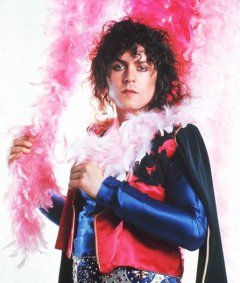
"the men don't know, but the little girls understand" -- from Back Door Man by Willie Dixon (sung by Howlin' Wolf, 1961)
THE RISE OF GLAM ROCK
Marc Bolan (T.Rex)
"At nine years old I became Elvis Presley" -- Marc Bolan
"Long before David Bowie, Gary Glitter or even Alvin Stardust tightened a single pant, brushed on the first load of non-drip paint, our man Bolan was single-handedly revising the whole concept of teen idolatry and big boppin' hits" -- Chris Welch, Melody Maker 1974 on Marc Bolan of T.Rex
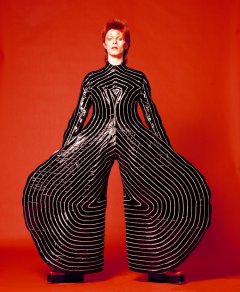
"The way he moves, it really gets me. The curls stick to his forehead with perspiration. It's so sexy. Everyone is afraid to step out of line in this world. But not Marc. That's what we all like about him. He represents what we would like to be" -- Marc Bolan fan Noelle Parr, age 15. 1972
"Marc brought in the Glam thing, but David [Bowie] took it a step further. Marc sort of stayed at one level of dressing up and wore lame jackets with musical notations on, and things like that.
"David came out with these beautiful bizarre costumes from Japan, designed by a top Japanese designer. Marc didn't think on that level.
"There was always this envy, this jealousy" -- Tony Visconti who produced both Bolan and Bowie
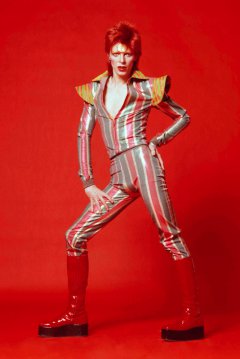
"I like T.Rex. They seem to be getting to be the new generation Beatles, with the girls tearing their trousers off. It's great at first but they'll soon tire of it all" -- Paul McCartney 1971
"When I run into serious trouble I'll sit down and knock you out five hits -- well easy. No problem." -- Marc Bolan 1974
The origins of T. Rex 1967-70
Originally Tyrannosaurus Rex, an acoustic hippie-era duo (Bolan and percussion layer Steve Peregrine Took replaced later by Mickey Finn).
Lyrics were archly poetic, often surreal, referred to mythology, rather fey and certainly non-threatening and almost always non-sexual . . .
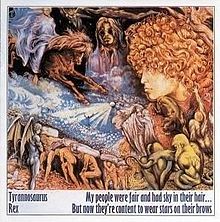
And albums laboured under titles like My People Were Fair and Had Sky in Their Hair, But Now They're Content to Wear Stars on Their Brows (1968) and Prophets, Seers and Sages; The Angels of the Ages (also '68)
Sometimes they would refer to Fifties rock'n'roll of the kind Bolan (born in '47) had grown up with.
Their hippie style much approved of by influential DJ John Peel.
Some samples of early Tyranosaurus Rex songs
Chateau in Virginia Waters, 1968
Dwarfish Trumpet Blues, 1968
Afghan Woman, 1968
but then an appreciable change to electric guitars and a more economic rock style in '70 with
Ride a White Swan (non-album single) 1970
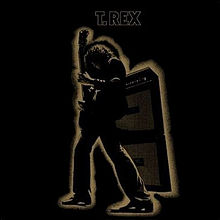
A new band emerged as T. Rex -- Ride a White Swan was followed by a similarly snappy single Hot Love -- was fronted by a glammed up Bolan.
The album Electric Warrior of '71 (right) completed the transition from hippie-pixie to glam-rock pop star. It sprung the hits Get It On (aka Bang a Gong) and Jeepster. It topped the UK charts . . . and previous supporter John Peel felt betrayed and was sometimes withering in his condemnation. Like many, he saw Bolan selling out art for fame.
So . . . the men don't know, but the little girls understand?
Bolan: "I think Electric Warrior, for me, is the first album which is a statement of 1971 for us in England. . . . that album says it, for me."
Bolan usurped by Bowie
Starman 1972 here
But by 1977 Bowie had grown past glam with Ziggy Stardust and then a move into electronica (after a period as a soul-styled singer). Bowie moved on, Bolan stayed in the same place and his audience of young kids grew up.
Critical reaction to glam?
Largely dismissed as facile pop, as with disco later it appears some rock critics felt uncomfortable with the androgynous nature of it (Bowie coming out) and the feminine sexuality which many males adopted, it came at a time when rock was taking itself very seriously with prog-rock and concept albums, it was aimed at teens (young girls particularly) and most critics and rock writers were males in the late 20s and early 30s . . .
"Strange how potent cheap music is" -- a character in Noel Coward's play Private Lives, 1930
THE PURE POP END OF GLAM
The pop music factory of Chinn-Chapman
Songwriters Nicky Chinn and Mike Chapman who wrote hits for and/or produced Sweet, Mud, Blondie, Racey . . .
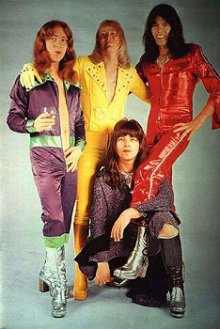 Sweet
Sweet
They had a remarkably successful run with Chinn-Chapman songs and had a number one single with Block Buster (the third biggest selling single of the year in the UK) and number two hit with Ballroom Blitz in '73.
Later they edged more towards hard rock
Sweet = pop without the sonic glam, although certainly the clothes?
Funny, Funny. 1971
Co-Co. 1971
Little Willy. 1972
.
Ballroom Blitz here
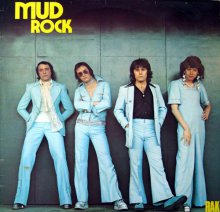 .
.
Mud
Tiger Feet -- by Chinn-Chapman -- was the biggest selling single in the UK in 1974.
Biggest selling album by a British artist -- after Simon and Garfunkel, and US-based Fleetwood Mac -- was Pink Floyd's Dark Side of the Moon.
The schism between the singles and albums charts -- and the audience for each -- could hardly be more graphically illustrated.
Interestingly though, Mud were more naturally inclined to covering old rock'n'roll songs (The Hippy Hippy Shake, See You Later Alligator, Chuck Berry songs etc) than being fully blown glam rockers.
Tiger Feet. 1974
Dyna-mite/The Cat Crept In/Tiger Feet medley. 1974
.
Gary Glitter
and -- aside from how unlike a teenage pop star this guy is -- it's interesting how these songs look BACK in their style and references.
.
Alvin Stardust
and more looking BACK
In his biggest hit (below) he channeled the look of Elvis Presley in his '68 comeback television special:
.
and Joan Jett from the US
although in her image she didn't look part of the glammed-up genre she was certainly included in it
and even more looking BACK
.
Wizzard
Roy Wood, formerly of British pop-rockers the Move in the Sixties reinvents himself with a widescreen sound in '72 which marries rock'n'roll, glam and the orchestral breath of the Electric Light Orchestra (which he had formed in '71 with Jeff Lynne).
and BACK again (Phil Spector-styled all-in production, the "jive" a dance from the late Fifties/early Sixties etc
See My Baby Jive here
AND
although glam was reductive and often simplistic, it brought teen-pop culture back into the centre of the frame and shifted the emphasis from albums to singles again.
This is as about as reductive as it gets: Racey from '79 with yet another Chinn-Chapman hit from their songwriting factory.
Some of it was just teenybopper music but people like the Bay City Rollers were huge with 12-year old girls (but weren't the Beatles initially?)
And glam-referencing Fifties rock'n'roll and old school pop (this a cover of a song made famous in the Sixties by Dusty Springfield)
HOWEVER: THE ART END OF GLAM
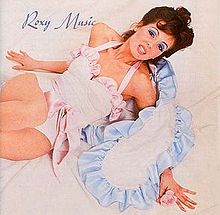 Roxy Music 1971-73
Roxy Music 1971-73
And although some of this was also looking back to earlier genres it mixed them up in a contemporary sounding manner and seemed to be looking forwards (more so than glam pop stars)
First two albums with Brian Eno as sound manipulator on stage and in the studio, redefined a kind of glam art-rock which referred to rock'n'roll, pure pop, cabaret and avant-garde music . . . all wrapped up in colourful clothes and sometimes with prominent glam-rock dance beat.
With the departure of Eno in early '73 the music steadily became more mainstream and the clothes less flamboyant.
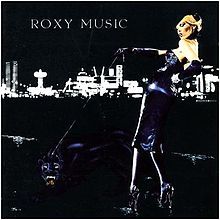 Visual style always important (singer/songwriter Bryan Ferry had graduated in fine art under Pop artist Richard Hamilton and was an art teacher at a London high school when he formed Roxy Music).
Visual style always important (singer/songwriter Bryan Ferry had graduated in fine art under Pop artist Richard Hamilton and was an art teacher at a London high school when he formed Roxy Music).
Eno too had studied art.
Album covers made an important statement about glam, kitsch and style . . . and had references in the culture of Fifties and Sixties advertising.
More on Roxy Music here. Brian Eno's early solo work after Roxy Music is addressed here.
Virginia Plain here
Ladytron here
Do the Strand here
.
Pop glam disappeared as fast as it arrived: Bolan dead in '77 but his star had already fallen; Bowie typically moved on fast; Sweet, Mud and others carried on but were increasingly irrelevant as their teen audience outgrew inane if enjoyable glam . . . and new genres emerged . . .


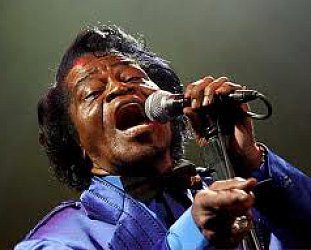
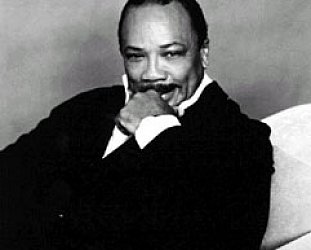

Jonathan Booth - Dec 6, 2021
Jesus and Mary Chain's Sidewalking single 1988, channeling some electric Bolan. Plus Bolan helped the very early The Damned. Enjoyed that whole read. Thanks Graham.
Savepost a comment